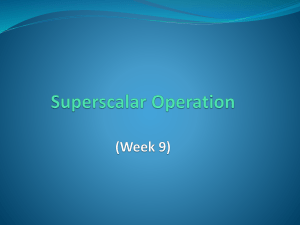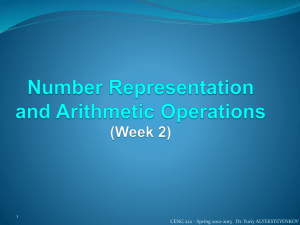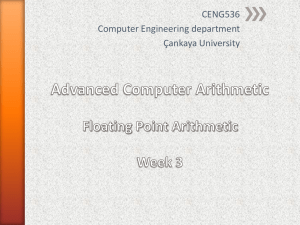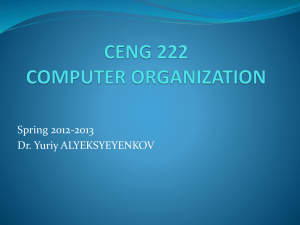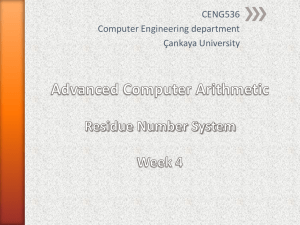PPP11-12
advertisement
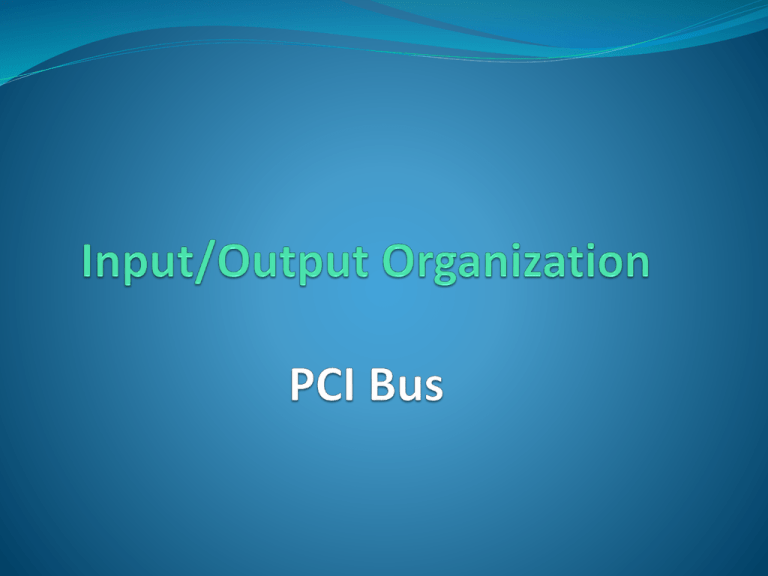
PCI Bus The PCI (Peripheral Component Interconnect) bus was developed as a low-cost, processor-independent bus. It is housed on the motherboard of a computer and used to connect I/O interfaces for a wide variety of devices. A device connected to the PCI bus appears to the processor as if it is connected directly to the processor bus. Its interface registers are assigned addresses in the address space of the processor. We will start by describing how the PCI bus operates, then discuss some of its features. Bus Structure The use of the PCI bus in a computer system is illustrated in figure. The PCI bus is connected to the processor bus via a controller called a bridge. The bridge has a special port for connecting the computer’s main memory. It may also have another special high speed port for connecting graphics devices. The bridge translates and relays commands and responses from one bus to the other and transfers data between them. 2 CENG 222 - Spring 2012-2013 Dr. Yuriy ALYEKSYEYENKOV PCI Bus When the processor sends a Read request to an I/O device, the bridge forwards the command and address to the PCI bus. When the bridge receives the device’s response, it forwards the data to the processor using the processor bus. I/O devices are connected to the PCI bus, possibly through ports that use standards such as Ethernet, USB, SATA, SCSI, or SAS. 3 CENG 222 - Spring 2012-2013 Dr. Yuriy ALYEKSYEYENKOV PCI Bus 4 The PCI bus supports three independent address spaces: memory, I/O, and configuration. The system designer may choose to use memorymapped I/O even with a processor that has a separate I/O address space. In fact, this is the approach recommended by the PCI standard for wider compatibility. The configuration space is intended to give the PCI its plug-and-play capability, as we will explain shortly. A 4-bit command that accompanies the address identifies which of the three spaces is being used in a given data transfer operation. Data transfers on a computer bus often involve bursts of data rather than individual words. Words stored in successive memory locations are transferred directly between the memory and an I/O device such as a disk or an Ethernet connection. Data transfers are initiated by the interface of the I/O device, which acts as a bus master. This way of transferring data directly between the memory and I/O devices wıll be discussed later. The PCI bus is designed primarily to support multiple-word transfers. A Read or a Write operation involving a single word is simply treated as a burst of length one. CENG 222 - Spring 2012-2013 Dr. Yuriy ALYEKSYEYENKOV PCI Bus. Data Transfer. 5 We will examine a typical bus transaction. The bus master, which is the device that initiates data transfers by issuing Read and Write commands, is called the initiator in PCI terminology. The addressed device that responds to these commands is called a target. The main bus signals used for transferring data are listed in Table. There are 32 or 64 lines that carry address and data using a synchronous signaling scheme. The target-ready, TRDY#, signal is equivalent to the Slave-ready signal. In addition, PCI uses an initiator-ready signal, IRDY#, to support burst transfers. A complete transfer operation on the PCI bus, involving an address and a burst of data, is called a transaction. Consider a bus transaction in which an initiator reads four consecutive 32-bit words from the memory. The sequence of events on the bus is illustrated in figure. All signal transitions are triggered by the rising edge of the clock. We show the signals changing later in the clock cycle to indicate the delays they encounter. A signal whose name ends with the symbol # is asserted when in the low-voltage state. CENG 222 - Spring 2012-2013 Dr. Yuriy ALYEKSYEYENKOV PCI Bus. Data Transfer. Data transfer signals on the PCI bus. 6 CENG 222 - Spring 2012-2013 Dr. Yuriy ALYEKSYEYENKOV PCI Bus. Data Transfer. A Read operation on the PCI bus. 7 CENG 222 - Spring 2012-2013 Dr. Yuriy ALYEKSYEYENKOV PCI Bus. Data Transfer. The bus master, acting as the initiator, asserts FRAME# in clock cycle 1 to indicate the beginning of a transaction. At the same time, it sends the address on the AD lines and a command on the C/BE# lines. In this case, the command will indicate that a Read operation is requested and that the memory address space is being used. In clock cycle 2, the initiator removes the address, disconnects its drivers from the AD lines, and asserts IRDY# to indicate that it is ready to receive data. The selected target asserts DEVSEL# to indicate that it has recognized its address and is ready to respond. At the same time, it enables its drivers on the AD lines, so that it can send data to the initiator in subsequent cycles. Clock cycle 2 is used to accommodate the delays involved in turning the AD lines around, as the initiator turns its drivers off and the target turns its drivers on. The target asserts TRDY# in clock cycle 3 and begins to send data. It maintains DEVSEL# in the asserted state until the end of the transaction. 8 CENG 222 - Spring 2012-2013 Dr. Yuriy ALYEKSYEYENKOV PCI Bus. Data Transfer. We have assumed that the target is ready to send data in clock cycle 3. If not, it would delay asserting TRDY# until it is ready. The entire burst of data need not be sent in successive clock cycles. Either the initiator or the target may introduce a pause by deactivating its ready signal, then asserting it again when it is ready to resume the transfer of data. The C/BE# lines, which are used to send a bus command in clock cycle 1, are used for a different purpose during the rest of the transaction. Each of these four lines is associated with one byte on the AD lines. The initiator asserts one or more of the C/BE# lines to indicate which byte lines are to be used for transferring data. The initiator uses the FRAME# signal to indicate the duration of the burst. It deactivates this signal during the second-last word of the transfer. The initiator maintains FRAME# in the asserted state until clock cycle 5, the cycle in which it receives the third word. In response, the target sends one more word in clock cycle 6, then stops. After sending the fourth word, the target deactivates TRDY# and DEVSEL# and disconnects its drivers on the AD lines. 9 CENG 222 - Spring 2012-2013 Dr. Yuriy ALYEKSYEYENKOV PCI Bus. Device Configuration. When an I/O device is connected to a computer, several actions are needed to configure both the device interface and the software that communicates with it. PCI has a plug-and-play capability that greatly simplifies this process. A PCI interface includes a small configuration ROM memory that stores information about the I/O device connected to it. The configuration ROMs of all devices are accessible in the configuration address space, where they are read by the PCI initialization software whenever the system is powered up or reset. By reading the information in the configuration ROM, the software determines whether the device is a printer, a camera, an Ethernet interface, or a disk controller. It can further learn about various device options and characteristics. 10 CENG 222 - Spring 2012-2013 Dr. Yuriy ALYEKSYEYENKOV PCI Bus. Device Configuration. Devices connected to the PCI bus are not assigned permanent addresses that are built into their I/O interface hardware. Instead, device addresses are assigned by software during the initial configuration process. This means that when power is turned on, devices cannot be accessed using their addresses in the usual way, as they have not yet been assigned any address. A different mechanism is used to select I/O devices at that time. The PCI bus may have up to 21 connectors for I/O device interface cards to be plugged into. Each connector has a pin called Initialization Device Select (IDSEL#). This pin is connected to one of the upper 21 address/data lines, AD11 to AD31. A device interface responds to a configuration command if its IDSEL# input is asserted. The configuration software scans all 21 locations to identify where I/O device interfaces are present. For each location, it issues a configuration command using an address in which the AD line corresponding to that location is set to 1 and the remaining 20 lines are set to 0. 11 CENG 222 - Spring 2012-2013 Dr. Yuriy ALYEKSYEYENKOV PCI Bus. Device Configuration. If a device interface responds, it is assigned an address and that address is written into one of its registers designated for this purpose. Using the same addressing mechanism, the processor reads the device’s configuration ROM and carries out any necessary initialization. It uses the low-order address bits, AD0 to AD10, to access locations within the configuration ROM. This automated process means that the user simply plugs in the interface board and turns on the power. The software does the rest. The PCI bus has gained great popularity, particularly in the PC world. It is also used in many other computers, to benefit from the wide range of I/O devices for which a PCI interface is available. Both a 32-bit and a 64-bit configuration are available, using either a 33-MHz or 66MHz clock. A high-performance variant known as PCI-X is also available. It is a 64-bit bus that runs at 133 MHz. Yet higher performance versions of PCI-X run at speeds up to 533 MHz. 12 CENG 222 - Spring 2012-2013 Dr. Yuriy ALYEKSYEYENKOV SATA In the early days of the personal computer, the bus of a popular IBM computer called AT (Advanced Technology), which was based on Intel’s 8088 microprocessor bus, became an industry standard. It was named ISA, for Industry Standard Architecture. An enhanced version, including a definition of the basic software needed to support disk drives, was later named ATA, for AT Attachment bus. A serial version of the same architecture became known as SATA, which is now widely used as an interface for disks. Like all standards, several versions of SATA have been developed with added features and higher speeds. The original parallel version has been renamed PATA, but it is no longer used in new equipment. The basic SATA connector has 7 pins, connecting two twisted pairs and three ground wires. Differential transmission is used, with clock frequencies ranging from 1.5 to 6.0 Gigabits/s. Some of the recent versions provide an isochronous transmission feature to support audio and video devices. 13 CENG 222 - Spring 2012-2013 Dr. Yuriy ALYEKSYEYENKOV Basic Concepts The maximum size of the memory that can be used in any computer is determined by the addressing scheme. For example, a computer that generates 16-bit addresses is capable of addressing up to 216 = 64K (kilo) memory locations. Machines whose instructions generate 32-bit addresses can utilize a memory that contains up to 232 = 4G (giga) locations, whereas machines with 64-bit addresses can access up to 264 = 16E (exa) ≈ 16 × 1018 locations. The number of locations represents the size of the address space of the computer. The memory is usually designed to store and retrieve data in word-length quantities. Consider, for example, a byte-addressable computer whose instructions generate 32-bit addresses. When a 32-bit address is sent from the processor to the memory unit, the high order 30 bits determine which word will be accessed. If a byte quantity is specified, the low-order 2 bits of the address specify which byte location is involved. 15 CENG 222 - Spring 2012-2013 Dr. Yuriy ALYEKSYEYENKOV Basic Concepts Connection of the memory to the processor. 16 CENG 222 - Spring 2012-2013 Dr. Yuriy ALYEKSYEYENKOV Cache and Virtual Memory The processor of a computer can usually process instructions and data faster than they can be fetched from the main memory. Hence, the memory access time is the bottleneck in the system. One way to reduce the memory access time is to use a cache memory. This is a small, fast memory inserted between the larger, slower main memory and the processor. It holds the currently active portions of a program and their data. Virtual memory is another important concept related to memory organization. With this technique, only the active portions of a program are stored in the main memory, and the remainder is stored on the much larger secondary storage device. Sections of the program are transferred back and forth between the main memory and the secondary storage device in a manner that is transparent to the application program. As a result, the application program sees a memory that is much larger than the computer’s physical main memory. 17 CENG 222 - Spring 2012-2013 Dr. Yuriy ALYEKSYEYENKOV Block Transfers The discussion above shows that data move frequently between the main memory and the cache and between the main memory and the disk. These transfers do not occur one word at a time. Data are always transferred in contiguous blocks involving tens, hundreds, or thousands of words. Data transfers between the main memory and high-speed devices such as a graphic display or an Ethernet interface also involve large blocks of data. Hence, a critical parameter for the performance of the main memory is its ability to read or write blocks of data at high speed. This is an important consideration that we will encounter repeatedly as we discuss memory technology and the organization of the memory system. 18 CENG 222 - Spring 2012-2013 Dr. Yuriy ALYEKSYEYENKOV Semiconductor RAM Memories Semiconductor random-access memories (RAMs) are available in a wide range of speeds. Their cycle times range from 100 ns to less than 10 ns. In this section, we discuss the main characteristics of these memories. We start by introducing the way that memory cells are organized inside a chip. 20 CENG 222 - Spring 2012-2013 Dr. Yuriy ALYEKSYEYENKOV Internal Organization of Memory Chips Organization of bit cells in a memory chip. 21 CENG 222 - Spring 2012-2013 Dr. Yuriy ALYEKSYEYENKOV Internal Organization of Memory Chips Memory cells are usually organized in the form of an array, in which each cell is capable of storing one bit of information. A possible organization is illustrated in figure. Each row of cells constitutes a memory word, and all cells of a row are connected to a common line referred to as the word line, which is driven by the address decoder on the chip. The cells in each column are connected to a Sense/Write circuit by two bit lines, and the Sense/Write circuits are connected to the data input/output lines of the chip. During a Read operation, these circuits sense, or read, the information stored in the cells selected by a word line and place this information on the output data lines. During a Write operation, the Sense/Write circuits receive input data and store them in the cells of the selected word. 22 CENG 222 - Spring 2012-2013 Dr. Yuriy ALYEKSYEYENKOV Internal Organization of Memory Chips Figure is an example of a very small memory circuit consisting of 16 words of 8 bits each. This is referred to as a 16 × 8 organization. The data input and the data output of each Sense/Write circuit are connected to a single bidirectional data line that can be connected to the data lines of a computer. Two control lines, R/W and CS, are provided. The R/W (Read/Write) input specifies the required operation, and the CS (Chip Select) input selects a given chip in a multichip memory system. The memory circuit in this figure stores 128 bits and requires 14 external connections for address, data, and control lines. It also needs two lines for power supply and ground connections. Consider now a slightly larger memory circuit, one that has 1K (1024) memory cells. This circuit can be organized as a 128 × 8 memory, requiring a total of 19 external connections. Alternatively, the same number of cells can be organized into a 1K×1 format. In this case, a 10-bit address is needed, but there is only one data line, resulting in 15 external connections. 23 CENG 222 - Spring 2012-2013 Dr. Yuriy ALYEKSYEYENKOV Internal Organization of Memory Chips Organization of a 1K × 1 memory chip. 24 CENG 222 - Spring 2012-2013 Dr. Yuriy ALYEKSYEYENKOV Internal Organization of Memory Chips The required 10-bit address is divided into two groups of 5 bits each to form the row and column addresses for the cell array. A row address selects a row of 32 cells, all of which are accessed in parallel. But, only one of these cells is connected to the external data line, based on the column address. Commercially available memory chips contain a much larger number of memory cells than the examples shown. We use small examples to make the figures easy to understand. Large chips have essentially the same organization, but use a larger memory cell array and have more external connections. For example, a 1G-bit chip may have a 256M × 4 organization, in which case a 28-bit address is needed and 4 bits are transferred to or from the chip. 25 CENG 222 - Spring 2012-2013 Dr. Yuriy ALYEKSYEYENKOV Static Memories Memories that consist of circuits capable of retaining their state as long as power is applied are known as static memories. Figure illustrates how a static RAM (SRAM) cell may be implemented. Two inverters are cross-connected to form a latch. The latch is connected to two bit lines by transistors T1 and T2. 26 CENG 222 - Spring 2012-2013 Dr. Yuriy ALYEKSYEYENKOV Static Memories These transistors act as switches that can be opened or closed under control of the word line. When the word line is at ground level, the transistors are turned off and the latch retains its state. For example, if the logic value at point X is 1 and at point Y is 0, this state is maintained as long as the signal on the word line is at ground level. Assume that this state represents the value 1. Read Operation In order to read the state of the SRAM cell, the word line is activated to close switches T1 and T2. If the cell is in state 1, the signal on bit line b is high and the signal on bit line b is low. The opposite is true if the cell is in state 0. Thus, b and b are always complements of each other. The Sense/Write circuit at the end of the two bit lines monitors their state and sets the corresponding output accordingly. Write Operation During a Write operation, the Sense/Write circuit drives bit lines b and b, instead of sensing their state. It places the appropriate value on bit line b and its complement on b and activates the word line. This forces the cell into the corresponding state, which the cell retains when the word line is deactivated. 27 CENG 222 - Spring 2012-2013 Dr. Yuriy ALYEKSYEYENKOV Dynamic RAMs Static RAMs are fast, but their cells require several transistors. Less expensive and higher density RAMs can be implemented with simpler cells. But, these simpler cells do not retain their state for a long period, unless they are accessed frequently for Read or Write operations. Memories that use such cells are called dynamic RAMs (DRAMs). Information is stored in a dynamic memory cell in the form of a charge on a capacitor, but this charge can be maintained for only tens of milliseconds. Since the cell is required to store information for a much longer time, its contents must be periodically refreshed by restoring the capacitor charge to its full value. This occurs when the contents of the cell are read or when new information is written into it. 28 CENG 222 - Spring 2012-2013 Dr. Yuriy ALYEKSYEYENKOV Dynamic RAMs An example of a dynamic memory cell that consists of a capacitor, C, and a transistor, T, is shown in figure. To store information in this cell, transistor T is turned on and an appropriate voltage is applied to the bit line. This causes a known amount of charge to be stored in the capacitor. After the transistor is turned off, the charge remains stored in the capacitor, but not for long. The capacitor begins to discharge. This is because the transistor continues to conduct a tiny amount of current, measured in pico amperes, after it is turned off. 29 CENG 222 - Spring 2012-2013 Dr. Yuriy ALYEKSYEYENKOV Dynamic RAMs A256-Megabit DRAM chip, configured as 32M × 8, is shown in figure. The cells are organized in the form of a 16K × 16K array. The 16,384 cells in each row are divided into 2,048 groups of 8, forming 2,048 bytes of data. Therefore, 14 address bits are needed to select a row, and another 11 bits are needed to specify a group of 8 bits in the selected row. 30 CENG 222 - Spring 2012-2013 Dr. Yuriy ALYEKSYEYENKOV Dynamic RAMs 31 In total, a 25-bit address is needed to access a byte in this memory. The highorder 14 bits and the low-order 11 bits of the address constitute the row and column addresses of a byte, respectively. To reduce the number of pins needed for external connections, the row and column addresses are multiplexed on 14 pins. During a Read or a Write operation, the row address is applied first. It is loaded into the row address latch in response to a signal pulse on an input control line called the Row Address Strobe (RAS). This causes a Read operation to be initiated, in which all cells in the selected row are read and refreshed. Shortly after the row address is loaded, the column address is applied to the address pins and loaded into the column address latch under control of a second control line called the Column Address Strobe (CAS). The information in this latch is decoded and the appropriate group of 8 Sense/Write circuits is selected. If the R/W control signal indicates a Read operation, the output values of the selected circuits are transferred to the data lines, D7−0. For a Write operation, the information on the D7−0 lines is transferred to the selected circuits, then used to overwrite the contents of the selected cells in the corresponding 8 columns. We should note that in commercial DRAM chips, the RAS and CAS control signals are active when low. CENG 222 - Spring 2012-2013 Dr. Yuriy ALYEKSYEYENKOV Fast Page Mode When the DRAM is accessed, the contents of all 16,384 cells in the selected row are sensed, but only 8 bits are placed on the data lines, D7−0. This byte is selected by the column address, bits A10−0. A simple addition to the circuit makes it possible to access the other bytes in the same row without having to reselect the row. Each sense amplifier also acts as a latch. When a row address is applied, the contents of all cells in the selected row are loaded into the corresponding latches. Then, it is only necessary to apply different column addresses to place the different bytes on the data lines. This arrangement leads to a very useful feature. All bytes in the selected row can be transferred in sequential order by applying a consecutive sequence of column addresses under the control of successive CAS signals. Thus, a block of data can be transferred at a much faster rate than can be achieved for transfers involving random addresses. The block transfer capability is referred to as the fast page mode feature. (A large block of data is often called a page.) It was pointed out earlier that the vast majority of main memory transactions involve block transfers. The faster rate attainable in the fast page mode makes dynamic RAMs particularly well suited to this environment. 32 CENG 222 - Spring 2012-2013 Dr. Yuriy ALYEKSYEYENKOV Synchronous DRAMs Synchronous DRAM. 33 CENG 222 - Spring 2012-2013 Dr. Yuriy ALYEKSYEYENKOV Synchronous DRAMs The cell array is the same as in asynchronous DRAMs. The distinguishing feature of an SDRAM is the use of a clock signal, the availability of which makes it possible to incorporate control circuitry on the chip that provides many useful features. For example, SDRAMs have built-in refresh circuitry, with a refresh counter to provide the addresses of the rows to be selected for refreshing. As a result, the dynamic nature of these memory chips is almost invisible to the user. 34 CENG 222 - Spring 2012-2013 Dr. Yuriy ALYEKSYEYENKOV Synchronous DRAMs A burst read of length 4 in an SDRAM. 35 CENG 222 - Spring 2012-2013 Dr. Yuriy ALYEKSYEYENKOV Synchronous DRAMs First, the row address is latched under control of the RAS signal. The memory typically takes 5 or 6 clock cycles (we use 2 in the figure for simplicity) to activate the selected row. Then, the column address is latched under control of the CAS signal. After a delay of one clock cycle, the first set of data bits is placed on the data lines. The SDRAM automatically increments the column address to access the next three sets of bits in the selected row, which are placed on the data lines in the next 3 clock cycles. Synchronous DRAM scan deliver data at a very high rate, because all the control signals needed are generated inside the chip. The initial commercial SDRAMs in the 1990s were designed for clock speeds of up to 133 MHz. As technology evolved, much faster SDRAM chips were developed. Today’s SDRAMs operate with clock speeds that can exceed 1 GHz. 36 CENG 222 - Spring 2012-2013 Dr. Yuriy ALYEKSYEYENKOV Structure of Larger Memories 37 We have discussed the basic organization of memory circuits as they may be implemented on a single chip. Next, we examine how memory chips may be connected to form a much larger memory. Static Memory Systems Consider a memory consisting of 2M words of 32 bits each. Figure shows how this memory can be implemented using 512K × 8 static memory chips. Each column in the figure implements one byte position in a word, with four chips providing 2M bytes. Four columns implement the required 2M × 32 memory. Each chip has a control input called Chip-select. When this input is set to 1, it enables the chip to accept data from or to place data on its data lines. The data output for each chip is of the tri-state type. Only the selected chip places data on the data output line, while all other outputs are electrically disconnected from the data lines. Twenty-one address bits are needed to select a 32-bit word in this memory. The high-order two bits of the address are decoded to determine which of the four rows should be selected. The remaining 19 address bits are used to access specific byte locations inside each chip in the selected row. The R/W inputs of all chips are tied together to provide a common Read/Write control line (not shown in the figure). CENG 222 - Spring 2012-2013 Dr. Yuriy ALYEKSYEYENKOV Structure of Larger Memories 38 Organization of a 2M × 32 memory module using 512K × 8 static memory chips. CENG 222 - Spring 2012-2013 Dr. Yuriy ALYEKSYEYENKOV Read-only Memories Both static and dynamic RAM chips are volatile, which means that they retain information only while power is turned on. Different types of nonvolatile memories have been developed. Generally, their contents can be read in the same way as for their volatile counterparts discussed above. But, a special writing process is needed to place the information into a nonvolatile memory. Since its normal operation involves only reading the stored data, a memory of this type is called a read-only memory (ROM). A ROM cell. 40 CENG 222 - Spring 2012-2013 Dr. Yuriy ALYEKSYEYENKOV Read-only Memories ROM A memory is called a read-only memory, or ROM, when information can be written into it only once at the time of manufacture. Figure shows a possible configuration for a ROM cell. A logic value 0 is stored in the cell if the transistor is connected to ground at point P; otherwise, a 1 is stored. PROM Some ROM designs allow the data to be loaded by the user, thus providing a programmable ROM (PROM). Programmability is achieved by inserting a fuse at point P in figure. Before it is programmed, the memory contains all 0s. The user can insert 1s at the required locations by burning out the fuses at these locations using high-current pulses. Of course, this process is irreversible. 41 CENG 222 - Spring 2012-2013 Dr. Yuriy ALYEKSYEYENKOV Read-only Memories EPROM Another type of ROM chip provides an even higher level of convenience. It allows the stored data to be erased and new data to be written into it. Such an erasable, reprogrammable ROM is usually called an EPROM. It provides considerable flexibility during the development phase of digital systems. An EPROM must be physically removed from the circuit for reprogramming. Also, the stored information cannot be erased selectively. The entire contents of the chip are erased when exposed to ultraviolet light. 42 CENG 222 - Spring 2012-2013 Dr. Yuriy ALYEKSYEYENKOV Read-only Memories EEPROM Another type of erasable PROM can be programmed, erased, and reprogrammed electrically. Such a chip is called an electrically erasable PROM, or EEPROM. It does not have to be removed for erasure. Moreover, it is possible to erase the cell contents selectively. One disadvantage of EEPROMs is that different voltages are needed for erasing, writing, and reading the stored data, which increases circuit complexity. However, this disadvantage is outweighed by the many advantages of EEPROMs. They have replaced EPROMs in practice. 43 CENG 222 - Spring 2012-2013 Dr. Yuriy ALYEKSYEYENKOV Read-only Memories Flash Memory An approach similar to EEPROM technology has given rise to flash memory devices. A flash cell is based on a single transistor controlled by trapped charge, much like an EEPROM cell. Also like an EEPROM, it is possible to read the contents of a single cell. The key difference is that, in a flash device, it is only possible to write an entire block of cells. Prior to writing, the previous contents of the block are erased. Flash devices have greater density, which leads to higher capacity and a lower cost per bit. They require a single power supply voltage, and consume less power in their operation. 44 CENG 222 - Spring 2012-2013 Dr. Yuriy ALYEKSYEYENKOV Read-only Memories Flash Cards One way of constructing a larger module is to mount flash chips on a small card. Such flash cards have a standard interface that makes them usable in a variety of products. A card is simply plugged into a conveniently accessible slot. Flash cards with a USB interface are widely used and are commonly known as memory keys. They come in a variety of memory sizes. Larger cards may hold as much as 32 Gbytes. A minute of music can be stored in about 1 Mbyte of memory, using the MP3 encoding format. Hence, a 32-Gbyte flash card can store approximately 500 hours of music. 45 CENG 222 - Spring 2012-2013 Dr. Yuriy ALYEKSYEYENKOV Read-only Memories Flash Drives Larger flash memory modules have been developed to replace hard disk drives, and hence are called flash drives. They are designed to fully emulate hard disks, to the point that they can be fitted into standard disk drive bays. However, the storage capacity of flash drives is significantly lower. Currently, the capacity of flash drives is on the order of 64 to 128 Gbytes. In contrast, hard disks have capacities exceeding a terabyte. Also, disk drives have a very low cost per bit. The fact that flash drives are solid state electronic devices with no moving parts provides important advantages over disk drives. They have shorter access times, which result in a faster response. They are insensitive to vibration and they have lower power consumption, which makes them attractive for portable, battery-driven applications. 46 CENG 222 - Spring 2012-2013 Dr. Yuriy ALYEKSYEYENKOV Direct Memory Access Blocks of data are often transferred between the main memory and I/O devices such as disks. Data are transferred from an I/O device to the memory by first reading them from the I/O device using an instruction such as Load R2, DATAIN which loads the data into a processor register. Then, the data read are stored into a memory location. The reverse process takes place for transferring data from the memory to an I/O device. An instruction to transfer input or output data is executed only after the processor determines that the I/O device is ready, either by polling its status register or by waiting for an interrupt request. In either case, considerable overhead is incurred, because several program instructions must be executed involving many memory accesses for each data word transferred. 48 CENG 222 - Spring 2012-2013 Dr. Yuriy ALYEKSYEYENKOV Direct Memory Access When transferring a block of data, instructions are needed to increment the memory address and keep track of the word count. The use of interrupts involves operating system routines which incur additional overhead to save and restore processor registers, the program counter, and other state information. An alternative approach is used to transfer blocks of data directly between the main memory and I/O devices, such as disks. A special control unit is provided to manage the transfer, without continuous intervention by the processor. This approach is called direct memory access, or DMA. The unit that controls DMA transfers is referred to as a DMA controller. 49 CENG 222 - Spring 2012-2013 Dr. Yuriy ALYEKSYEYENKOV Direct Memory Access Typical registers in a DMA controller. 50 CENG 222 - Spring 2012-2013 Dr. Yuriy ALYEKSYEYENKOV Direct Memory Access 51 To start a DMA transfer of a block of data from the main memory to one of the disks, an OS routine writes the address and word count information into the registers of the disk controller. The DMA controller proceeds independently to implement the specified operation. When the transfer is completed, this fact is recorded in the status and control register of the DMA channel by setting the Done bit. At the same time, if the IE bit is set, the controller sends an interrupt request to the processor and sets the IRQ bit. The status register may also be used to record other information, such as whether the transfer took place correctly or errors occurred. CENG 222 - Spring 2012-2013 Dr. Yuriy ALYEKSYEYENKOV
